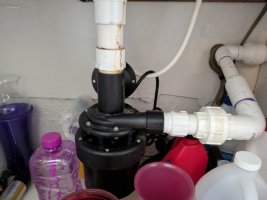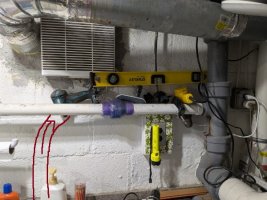I'm trying to install a utility sink pump and had a few questions. The current setup is a ventless pump which was installed when I purchased the house, that failed and I replaced it with a similar pump from Home Depot which also failed at about a year. I suspect washing my hands full of dirt may have caused the pumps to fail, but not sure. Enclosed picture of my current setup, the 2nd floor was added onto the house about 40 years ago so it looks like they tied in to the original cast iron sewer line.
Anyway I was looking for a more robust solution and considering the Liberty 404/405.
1) Will either of those units be less susceptible to failure due to dirt/silt? I see the 404 is rated for 3/8" size particles, but so was my previous pump which failed. The 405 is rated for "solids," but I can't find any more specifics than that.
2) Can I use my previous installation? The issue is the 404/405 have 1 1/2" outlets, but my current setup looks like maybe 1" or 3/4" outlets, could I just tie into that or do I have to do all new lines at 1 1/4" ?
3) I'm not sure how to tie into the sewer. The current tie in seems pretty mickey moused, they just tied it into the sewer clean out. Is this ok? If so where would I get such an adapter, the sewer pipe seems like it's 5" which doesn't seem like a typical size.
3a) A second option would be to tie into the drain pipe from the upstairs kitchen and basement washing machine, could I just tie in here with a wye? (enclosed picture)
4) For the 404/405 I need venting but don't have any vents to tie into. I know I can't use an AAV, but I had read somewhere about drilling 3x 1/8" holes into the AAV's threads to allow air flow, is this legit? 2nd choice would be to run a vent up to the ceiling, then horizontal about 10 feet to clear a home addition, then out through the rim joist, I'd really rather avoid that as it involves going through joists. 3rd choice, this will only be used as an occasional utility sink pump so do I need to worry about sewer gas with such a setup? Could I just vent a few feet inside of the sink, or will the standing water in the pump eventually smell?
Thanks in advance!
Anyway I was looking for a more robust solution and considering the Liberty 404/405.
1) Will either of those units be less susceptible to failure due to dirt/silt? I see the 404 is rated for 3/8" size particles, but so was my previous pump which failed. The 405 is rated for "solids," but I can't find any more specifics than that.
2) Can I use my previous installation? The issue is the 404/405 have 1 1/2" outlets, but my current setup looks like maybe 1" or 3/4" outlets, could I just tie into that or do I have to do all new lines at 1 1/4" ?
3) I'm not sure how to tie into the sewer. The current tie in seems pretty mickey moused, they just tied it into the sewer clean out. Is this ok? If so where would I get such an adapter, the sewer pipe seems like it's 5" which doesn't seem like a typical size.
3a) A second option would be to tie into the drain pipe from the upstairs kitchen and basement washing machine, could I just tie in here with a wye? (enclosed picture)
4) For the 404/405 I need venting but don't have any vents to tie into. I know I can't use an AAV, but I had read somewhere about drilling 3x 1/8" holes into the AAV's threads to allow air flow, is this legit? 2nd choice would be to run a vent up to the ceiling, then horizontal about 10 feet to clear a home addition, then out through the rim joist, I'd really rather avoid that as it involves going through joists. 3rd choice, this will only be used as an occasional utility sink pump so do I need to worry about sewer gas with such a setup? Could I just vent a few feet inside of the sink, or will the standing water in the pump eventually smell?
Thanks in advance!



